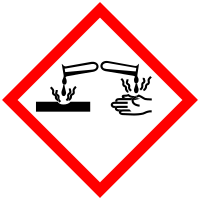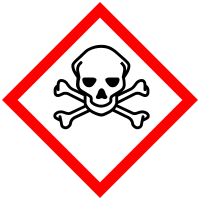
Improving Member States preparedness to face an HNS pollution of the Marine System (HNS-MS)
Methacrylic Acid
Description Top
| CAS number | 79-41-4 |
| UN number | 2531 |
| Chemical formula | C4H6O2 |
| Standard European Behaviour Classification (SEBC) | Dissolves (D) |
GESAMP Hazard profile
| A1 | A2 | B1 | B2 | C1 | C2 | C3 | D1 | D2 | D3 | E1 | E2 | E3 |
| 0 | R | 2 | 0 | 1 | 2 | 2 | 3 | 3 | NI | D | 3 |
Marine pollution Classification (MARPOL Annex II)
| Category | Description |
| Y | Noxious Liquid Substances which, if discharged into the sea from tank cleaning or deballasting operations, are deemed to present a hazard to either marine resources or human health or cause harm to amenities or other legitimate uses of the sea and therefore justify a limitation on the quality and quantity of the discharge into the marine environment. |
Alternate names for this chemical
2-Methacrylic Acid
2-Methyl-2-Propenoic Acid
Methacrylic Acid
Acide Methacrylique
2-Methyl-2-Propenoic Acid
Methacrylic Acid
Acide Methacrylique
Physico-chemical properties Top
| Chemical formula | C4H6O2 | ||
| Molar mass | 86.09 [g/mol] | ||
| State | Solid at 25°C and 1 atm | ||
| Fusion temperature | 16 [°C] | ||
| Boiling temperature | 162.5 [°C] | ||
| Density |
|
||
| Surface tension |
|
||
| Kinematic viscosity |
|
||
| Hydrosolubility |
|
||
| Vapour pressure |
|
||
| Vapour density | 2.97 | ||
| Flash point (Cleveland open cup) | 77 [°C] | ||
| Lower explosivity limit (LEL) | 1.6 [%] | ||
| Upper explosivity limit (UEL) | 8.8 [%] | ||
| Specific heat capacity | 1871 [J/(Kg·K)] | ||
| Henry's constant | 0.039 [mol/(m³·Pa)] |
Behaviour Top
| Log Kow | 0.93 |
| Log Koc | 0.35 |
| Hydrolysis (Half-life) | Not hydrolysable |
| Aqueous photolysis (Half-life) | Not photolysable |
| Standard European Behaviour Classification (SEBC) | Dissolves (D) |
| Bioconcentration factor (BCF) | 3.1 |
Ecotoxicity Top
| Lowest median lethal concentration (LC50) on algae | 45 [mg/l] | |
| Lowest median lethal concentration (LC50) on crustacean | 140 [mg/l] | |
| Lowest median lethal concentration (LC50) on fishes | 85 [mg/l] | |
| Highest no observed effect concentration (NOEC) on algae | 8.2 [mg/l] | |
| Highest no observed effect concentration (NOEC) on crustacean | 53 [mg/l] | |
| Highest no observed effect concentration (NOEC) on fishes | 10 [mg/l] | |
| Assessment factor (AF) |
|
|
| Predicted No Effect Concentration (PNEC) |
|
Hazards Top


Danger
Hazards statements
Health
H302
Harmful if swallowed.
H311
Toxic in contact with skin.
H314
Causes severe skin burns and eye damage.
H332
Harmful if inhaled.
H335
May cause respiratory irritation.
Precautionary statements
Prevention
P280
Wear protective gloves/protective clothing/eye protection/face protection.
Response
P303 + P361 + P353
IF ON SKIN (or hair): Remove/Take off immediately all contaminated clothing. Rinse skin with water/shower.
P305 + P351 + P338
IF IN EYES: Rinse cautiously with water for several minutes. Remove contact lenses, if present and easy to do. Continue rinsing.
Storage
P405
Store locked up.
Disposal
P501
Dispose of contents/container to ...
GESAMP Top
GESAMP Hazard profile
| A1 | A2 | B1 | B2 | C1 | C2 | C3 | D1 | D2 | D3 | E1 | E2 | E3 |
| 0 | R | 2 | 0 | 1 | 2 | 2 | 3 | 3 | NI | D | 3 |
A1: Bioaccumulation
| Rating | Description |
| 0 | No potential to bioaccumulate |
A1a:
| Rating | Description | Criteria [mg/l] |
| 0 | No potential to bioaccumulate | Log Kow < 1 |
A1b:
| Rating | Description |
| NI | No Information |
A2: Biodegradation
| Rating | Description |
| R | Readily biodegradable |
B1: Acute aquatic toxicity
| Rating | Description | Criteria [mg/l] |
| 2 | Slightly toxic | 10 < LC/EC/IC50 ≤ 100 |
B2: Chronic aquatic toxicity
| Rating | Description | Criteria [mg/l] |
| 0 | Negligible | NOEC > 1 |
C1: Acute oral toxicity
| Rating | Description | Criteria [mg/Kg] |
| 1 | Slight | 300 < AOTE ≤ 2000 |
C2: Acute dermal toxicity (skin contact)
| Rating | Description | Criteria [mg/Kg] |
| 2 | Moderate | 200 < ADTE ≤ 1000 |
C3: Acute inhalation toxicity
| Rating | Description | Criteria [mg/l] (4 hours exposure) |
| 2 | Moderate | 2 < AITE ≤ 10 |
D1: Skin irritation or corrosion
| Rating | Description | Sign | GHS category |
| 3 | Severely irritating or corrosive | Severe irritation indi | Corrosive Category 1 |
D2: Eye irritation
| Rating | Description | Sign | GHS category |
| 3 | Severely irritating or corrosive | Severe conjunctoblepha | Irritant Category 1 |
D3: Long-term health effects
| Notation | Hazard endpoint | Description | GHS category |
| No Information |
E1: Tainting of seafood
| Rating | Description |
| NI | No Information |
E2: Behaviour of chemicals in the marine environment
| Rating | Description |
| D | Dissolves |
E3: Interference with the use of coastal amenities
| Rating | Interference | Description | Interpretation | Warning |
| 3 | Highly objectionable | 1 is highly acutely toxic; and/or 2 is severely irritant or corrosive to skin or eyes; and/or 3 is carcinogenic, mutagenic or reprotoxic; and/or 4 is a floater or persistent floater with associated health effects | 1 C1 and/or C2 and/or C3 = 4; and/or 2 D1 or D2 = 3, 3A, 3B, or 3C; and/or 3 D3 contains C, M or R; and/or 4 E2 = F or Fp and D3 contains Ss, Sr, T, A, N, or I | Warning issued leading to the closure of amenities |
GHS Security Information


Danger
About the project
HNS-MS is a decision-support tool that Belgian and French maritime authorities as well as coastguard stations can activate in order to forecast the drift, fate and behavior of acute marine pollution by Harmful Noxious Substances (HNS) accidentally released in the marine system.
Contact us
Copyright © 2015–2025 HNS-MS Consortium
 HNS-MS has been funded by DG-ECHO under agreement ECHO/SUB/2014/693705 and runs from 1 January 2015 to 31 March 2017.
HNS-MS has been funded by DG-ECHO under agreement ECHO/SUB/2014/693705 and runs from 1 January 2015 to 31 March 2017.